Primary Ba Semi-amplitude (K2)(secondary) 32.6 km/s Distance to Earth 864.3 light years Mass 3.58 × 10^31 kg (18 M☉) Constellation Orion | Companion Bb Surface temperature 11,000 K Radius 54.29 million km (78 R☉) Magnitude 0.12 | |
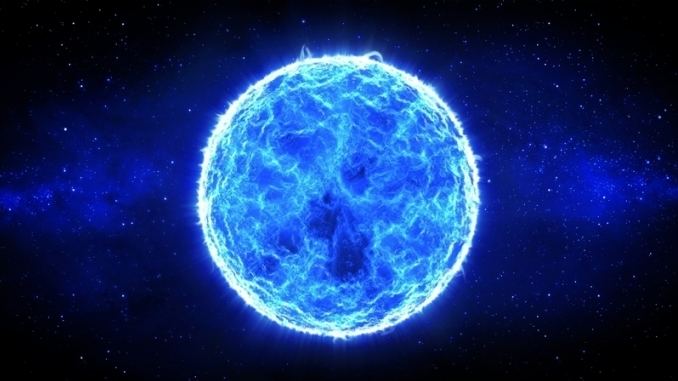 | ||
Luminosity (bolometric) 7000120000000000000♠1.20+0.25−0.21×10 L☉ Similar Betelgeuse, Sirius, Aldebaran, Bellatrix, Arcturus | ||
Scale of earth sun rigel and vy canis majoris full zoom at the end
Rigel, also designated Beta Orionis (β Orionis, abbreviated Beta Ori, β Ori), is generally the seventh-brightest star in the night sky and the brightest star in the constellation of Orion—though periodically it is outshone within the constellation by the variable Betelgeuse. With a visual magnitude of 0.13, it is a remote and luminous star some 863 light-years distant from Earth.
Contents
- Scale of earth sun rigel and vy canis majoris full zoom at the end
- Pleasurekraft rigel official video
- Nomenclature
- Visibility
- Parallax
- System
- Properties
- Space photometry
- Spectroscopy
- References
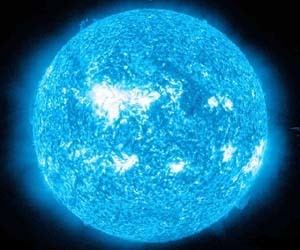
The star as seen from Earth is actually a multiple star system of three to five stars, the primary star being (Rigel A) a blue-white supergiant which is estimated to be anywhere from 120,000 to 279,000 times as luminous as the Sun, depending on the method used to calculate its properties. It has exhausted its core of hydrogen and swollen out to between 79 and 115 times the Sun's radius. It pulsates quasi-periodically and is classified as an Alpha Cygni variable. A companion, Rigel B, is 500 times fainter than the supergiant Rigel A and visible only with a telescope. Rigel B is itself a spectroscopic binary system, consisting of two main sequence blue-white stars of spectral type B9V that are estimated to be respectively 3.9 and 2.9 times as massive as the Sun, Rigel Bb may itself be a binary. Rigel B also appears to have a very close visual companion Rigel C of almost identical appearance.
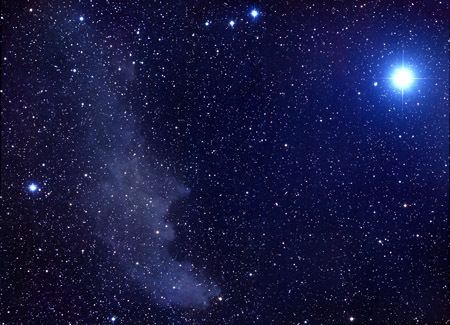
Pleasurekraft rigel official video
Nomenclature
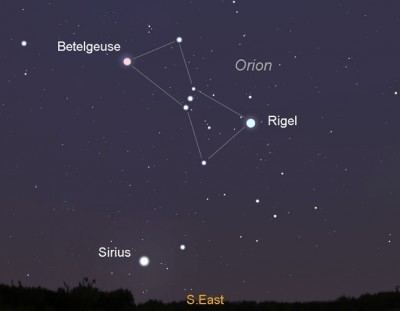
Beta Orionis is the star's Bayer designation. The traditional name Rigel is first recorded in the Alfonsine Tables of 1252. It is derived from the Arabic name Rijl Jauzah al Yusrā, "the left leg (foot) of Jauzah" (i.e. rijl meaning "leg, foot"), which can be traced to the 10th century. "Jauzah" was a proper name of the Orion figure, an alternative Arabic name was رجل الجبار riǧl al-ǧabbār, "the foot of the great one", which is the source of the rarely used variant names Algebar or Elgebar. The Alphonsine Tables saw its name split into "Rigel" and "Algebar", with the note, "et dicitur Algebar. Nominatur etiam Rigel." Alternate spellings from the 17th century include Regel by Giovanni Battista Riccioli, Riglon by Wilhelm Schickard, and Rigel Algeuze or Algibbar by Edmund Chilmead.
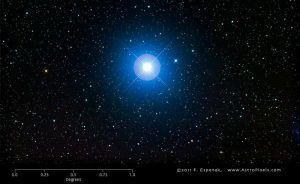
In 2016, the International Astronomical Union organized a Working Group on Star Names (WGSN) to catalog and standardize proper names for stars. The WGSN's first bulletin of July 2016 included a table of the first two batches of names approved by the WGSN; which included Rigel for this star. It is now so entered in the IAU Catalog of Star Names.
Rigel is presumably the star known as "Aurvandil's toe" in Norse mythology.
In Chinese astronomy, Rigel is the seventh star of the "Three Stars" asterism, 参宿七 (Shēnxiù Qī). In Japan, the Minamoto or Genji clan had chosen Rigel and its white color as its symbol, calling the star Genji-boshi (源氏星), while the Taira or Heike clan adopted Betelgeuse and its red color. The two powerful families fought a legendary war in Japanese history, the stars seen as facing each other off and only kept apart by the Belt. Rigel was also known as Gin-waki, (銀脇), "the Silver (Star) beside (Mitsu-boshi)."
Rigel was known as Yerrerdet-kurrk to the Wotjobaluk koori of southeastern Australia, and held to be the mother-in-law of Totyerguil (Altair). The distance between them signified the taboo preventing a man from approaching his mother-in-law. The indigenous Boorong people of northwestern Victoria named Rigel as Collowgullouric Warepil. The Wardaman people of northern Australia know Rigel as the Red Kangaroo Leader Unumburrgu and chief conductor of ceremonies in a songline when Orion is high in the sky. The river Eridanus marks a line of stars in the sky leading to it, and the other stars of Orion are his ceremonial tools and entourage. Betelgeuse is Ya-jungin "Owl Eyes Flicking", watching the ceremonies.
The Māori people named Rigel as Puanga and was said to be a daughter of Rehua (Antares), the chief of all stars. Its heliacal rising also presaged the appearance of Matariki (the Pleiades) in the dawn sky which marked the Māori New Year in late May or early June. The Moriori people of the Chatham Islands, as well as some Maori groups in New Zealand marked the start of their New Year with Rigel rather than the Pleiades. Puaka was a local variant used in the South Island.
The Lacandon people knew it as tunsel "little woodpecker".
Visibility
The apparent visual magnitude of Rigel is 0.13, making it on average the seventh-brightest star in the celestial sphere excluding the Sun—just fainter than Capella. It is an irregular pulsating variable with a visual range of magnitude 0.05–0.18. Although Rigel has the Bayer designation "beta", it is almost always brighter than Alpha Orionis (Betelgeuse). Since 1943, the spectrum of this star has served as one of the stable anchor points by which other stars are classified. Rigel is the third most inherently luminous first magnitude star after Deneb and Betelgeuse. Rigel has a color index (B–V) of −0.03, meaning it appears white or slightly blue-white.
Culminating at midnight on 12 December, and at 9 pm on 24 January, Rigel is most visible in winter evenings in the northern hemisphere and summer in the southern. In the southern hemisphere, Rigel is the first bright star of Orion visible as the constellation rises. In stellar navigation, Rigel is one of the most important navigation stars, since it is bright, easily located and equatorial, which means it is visible all around the world's oceans (the exception, areas within 8° of the North Pole).
Parallax
The revised 2007 Hipparcos reduction of Rigel's parallax gives a distance of 863 light-years (265 parsecs), with a margin of error of about 9%. Earlier spectroscopic estimates placed its distance between 360 and 500 parsecs (1,200 and 1,600 light-years).
System
Rigel has been known as a visual double star since at least 1822, when it was measured by Friedrich Georg Wilhelm von Struve. The companion is not particularly faint at magnitude 6.7, and with a separation of 9.5 arcsec both components are resolvable in most amateur astronomers' telescopes. However, the large difference in brightness makes it a challenging target for telescope apertures smaller than 15.0 cm (5.9 in). At Rigel's estimated distance, Rigel B's projected separation from its primary is over 2200 AU. Since its discovery, there has been no sign of orbital movement, although both stars share similar common proper motion. The pair would have a minimum orbital period of around 18,000 years.
Since the 19th century, Rigel B has been reported to be resolved into a close binary of two equal components, with the measured separation varying from less than 0.1" to nearly 0.2". Speckle interferometry showed in 2009 two almost identical components separated by 0.124". Both stars have apparent visual magnitudes of 7.6 with a likely orbital period of 63 years.
Rigel Bb may itself be a spectroscopic binary system, consisting of two main sequence stars that orbit each other every 9.86 days. The stars both belong to the spectral class B9. These two stars do not appear to make up the visual binary components of B or C, so the B sub-system might be a triple star, although the true arrangement of them is unclear.
A 15.4 magnitude star at 44.6 arcsec in north position angle of 1° is catalogued as component D in the system although it is unclear whether it is physically related or a coincidental alignment.
Properties
Moravveji and colleagues calculate a luminosity for Rigel A of 120,000 times that of the Sun. Its surface temperature is around 12,100 K. The interferometer-measured angular diameter of this star, after correction for limb darkening, is 7000275000000000000♠2.75±0.01 mas. At its estimated distance, this yields a size of about 79 times the radius of the Sun. Norbert Przybilla and colleagues used atmospheric modelling in 2006 to come up with a distance of 360 ± 40 parsecs (1,170 ± 130 light-years). They calculated it to be around 218,000 times as luminous as the Sun, and have around 21±3 solar masses and 109±12 times its radius. The CMFGEN code is an atmosphere code used to determine the properties of massive stars from analysing their spectrum and atmosphere. Analysis of Rigel using this method yields a luminosity 279,000 times that of the Sun, a radius 115 times that of the Sun and stellar wind velocity of 671,080 miles per hour.
Rigel A is a blue supergiant that has exhausted burning the hydrogen fuel in its core and left the main sequence, expanding and brightening as it progresses across the Hertzsprung–Russell diagram. Przybilla estimated that it has lost around 3 solar masses since beginning life as a star of 24 ± 3 solar masses 7 to 9 million years ago. It will become a red supergiant and eventually end its stellar life by exploding as a type II supernova, in the process flinging out material that will serve to seed future generations of stars. It is one of the closest known potential supernova progenitors to Earth.
Rigel's variability is complex and is caused by stellar pulsations similar to those of Deneb, the prototype of the class of Alpha Cygni pulsating stars. The radial velocity variations of Rigel proves that it simultaneously oscillates in at least 19 non-radial modes with periods ranging from about 1.2 to 74 days. It is notable among blue supergiant stars in the sense that while its pulsations are powered by the nuclear reactions in a hydrogen-burning shell that is at least partially non-convective, the star also burns helium in its core. Rigel was identified as belonging to the Alpha Cygni variables in 1998 by Christoffel Waelkens and colleagues.
As it is both bright and moving through a region of nebulosity, Rigel lights up several dust clouds in its vicinity, most notably the IC 2118 (the Witch Head Nebula). Rigel is also associated with the Orion Nebula, which—while more or less along the same line of sight as the star—is almost twice as far away from Earth. Despite the difference in distance, projecting Rigel's path through space for its expected age brings it close to the nebula. As a result, Rigel is sometimes classified as an outlying member of the Orion OB1 Association although it is considerably closer than most of the members. Betelgeuse and Saiph lie at a similar distance to Rigel, although Betelgeuse is a runaway star with a complex history and is likely to have originally formed in the main body of the association. It has been listed as a member of the poorly-defined Taurus-Orion R1 Association
The companions Rigel Ba, Bb, and C all appear to be similar B class main sequence stars of 3 - 4 M☉, but their properties are not accurately known.
Space photometry
Rigel was observed with the Canadian MOST satellite for nearly 28 days in 2009. The light variations in this supergiant star were at the milli magnitude level. The gradual changes in the flux highlights the presence of long-period pulsation modes in the star.
Spectroscopy
The general spectral type of Rigel as B8 is well-established and it has been used as a defining point of the spectral classification sequence for supergiants. However the details of the spectrum vary considerably owing to periodic atmospheric eruptions. The spectral lines show emission, absorption, line doubling, P Cygni profiles, and inverse P Cygni profiles, with no obvious periodicity. This has resulted in classification as B8 Iab, B8 Iae, or blendings by different authors.
